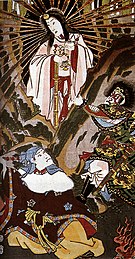Susanoo

Susanoo (Japanese: 須佐之男命, Susanoo-no-Mikoto; also romanized as Susano'o, Susa-no-O, and Susanowo) is the kami of the sea and storms in Shinto.
Susano'o is the brother of Amaterasu, the goddess of the sun, and of Tsukuyomi, the god of the moon. All three were created from Izanagi, when he washed his face to clean the dirtiness of Yomi, the underworld. Amaterasu was born when Izanagi washed out his left eye, Tsukuyomi was born from the washing of the right eye, and Susano'o from the washing of the nose.
The tales tell of great rivalry between Susano'o and his sister. When he was to leave Heaven forever because Izanagi ordered him to, he went to say goodbye to his sister. Amaterasu, suspicious, proposed him a challenge: each of them was to turn an object of the other's into people. Amaterasu created three women from Susano'o's sword while he created five men from her necklace. Amaterasu said the men were hers because they were born of her necklace. Susano'o destroyed her rice fields, threw a dead pony into her loom, and killed one of her assistants in anger. For this, Amaterasu, sad, angry and scared, went to hide inside Ama-no-Iwato, the "heavenly rock cave", so the Sun was hidden and the world became dark for a long time.
Amaterasu later was made to come out of the cave, but Susano'o was punished by being banished from Heaven. He came down to the province of Izumo, where he met an old couple. Seven of their eight daughters had been eaten by the eight-headed serpent Yamata-no-Orochi and it was about to come for the eighth, Kushi-inada-hime. After the couple promised their daughter's hand in marriage to Susano'o, he agreed to kill Orochi. With the help of eight bowls of sake (one for each head), Susano'o cut the head off the monster when it was sleeping.
From one of Orochi's tails, Susano'o took out a sword, which he called Ame-no-Murakumo-no-Tsurugi ("Heaven's Cloud-Gathering Sword"), later known as the Kusanagi-no-Tsurugi. The sword was given to Amaterasu as a reconciliation gift and was later given to her descendant Ninigi (the great-grandfather of Emperor Jimmu), with the Yata-no-Kagami (a mirror) and magatama (sacred jewels) as proof of his divine right to rule on Earth (the three Imperial Regalia of Japan).
Izumo
Amaterasu's shrine is at Ise Shrine, and Susano'o's is in Izumo, where he came down to Earth when banished from heaven. Izumo is home to the oldest shrines in Japan.
In popular culture
In a Meitei language play named Yamata Amasung Keibu Keioiba (English: Yamata-no-Orochi and Keibu Keioiba), the role of Susanoo was played by Romario Thoudam Paona. The play interweaves the stories of two legendary creatures, Yamata-no-Orochi of Japanese mythology and Keibu Keioiba of Meitei mythology (Manipuri mythology).[1][2]
References
- ↑ "YAMATA AMASUNG KEIBU KEIOIBA – 21st Bharat Rang Mahotsav 2020". Archived from the original on 2021-04-22.
- ↑ "Heisnam Tomba's Play: Yamata Amasung Keibu Keioiba". StageBuzz. 2020-02-16.
 |
|
|
Mythic Texts and Folktales:
|